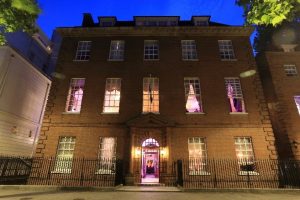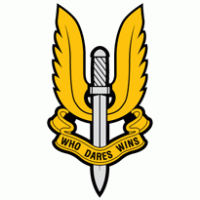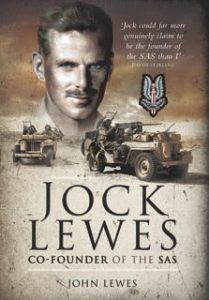
Was held at The Caledonian Club, 19 Halkin St., Belgrave Square.
The guest Speaker was John Lewes.

John Lewes has a very particular interest in the creation of the SAS (Special Air Service Regiment) as the nephew of Lt. JOCK LEWES who together with DAVID STIRLING created this famous unit in North Africa during the second World War.
Jock Lewes, recently commissioned into the Welsh Guards, quickly proved despite his lack of military experience, to be a radical tactical thinker, and a brilliant leader and trainer of men, and a very courageous front-line soldier – a very rare combination. In 1941 Britain was very close to losing the war, with most of our shipping in the Mediterranean being sunk by enemy aircraft operating from airfields in north Africa. Jock Lewes realised immediately on arrival in north Africa that these aircraft and their airfields had to be put out of action, and that was the task he set himself with small groups of men, carefully trained and selected by him.
John’s personal connection to these extraordinary events, and the in-depth research he has done, made his attendance at the Chelsea Society’s Christmas dinner a special treat for members and guests.
John has a history degree from the University of Liverpool, and studied at the Bristol Old Vic Theatre School and the University of London. He was a Flying officer in the RAF (VRT) and is an Honorary Member of the Welsh Guards Association. He has been interviewed by Dan Snow and appeared on BBC2’s SAS: Rogue Warriors presented by Ben Macintyre.

John is alsoJock Lewes’s biographer, and has written a novel “A Spy after All” based on the true story of the early days of the SAS. “A Spy After All” retails at £19.99 but on this occasion it was offered to members at £14.99.

“Jock Lewes Co-founder of the SAS” is priced at £14.99.
The talk which John Lewes gave at the dinner is as follows:

Good evening ladies and gentlemen. I’d like to thank Dr Thompson the chairman, Michael Stephen the Vice-chairman, and Joanna Thorneycroft for kindly first inviting me here for tonight’s talk, also Sir Paul and Lady Lever, the members of the committee, and the Chelsea Society with friends – for your warm welcome. The name Chelsea has a special ring to it, which I realise so many of you work so hard to preserve on countless projects to maintain and enhance this special area. One of my godparents, Edith Baird, in her youth, came to study at the Art College here – it caught her eye then because she thought it was by the sea! Studying here was fortuitous because she went on to design outfits for Her Majesty the Queen.
That brings us on to the very distinguished young officer and patriot, Lieutenant Jock Lewes.
Few in Britain would dispense with the services of the Special Forces, especially post 9/11. Of the few who were aware of the SAS in the early 1940s, there were some who valued the fledgling SAS, but not many, even though Britain was spectacularly losing the Second World War at a time when Churchill called for action in November 1941 – a time when 90% of Allied shipping bound for Malta lay at the bottom of the Mediterranean.
My account explores how a special service was talked about in the North African desert where the British were still able to engage the enemy. However, there was not much special service to be seen in early 1941.
David Stirling, Jock Lewes’s first co-founder, saw the value of Jock’s pioneering parachute detachment later in 1941, and of course became the politician of the elite force, networking the right contacts to enlarge Jock’s parachute detachment tenfold, outliving Jock, and evolving the SAS Brigade into the Regiment. Another fascinating tale. However, the scope of this particular talk focuses on Lieutenant Jock Lewes and the six months before the SAS’s inception, and how it was Jock in fact who first took the initiative to fully regenerate special service – mostly by his actions.
Jock’s father, Arthur Lewes, had been in the Calcutta firm, Lovelock and Lewes Chartered Accountants, before Arthur married Elsie Steel whose family had moved to Australia to solve disputes in the Presbyterian church.
Jock was their eldest boy and enjoyed a strict but loving upbringing where no passer-by in the Depression was turned away for a meal at the kitchen table. In the Bowral countryside, it was also possible for Jock and his brother David, my father, to use a school-size chemistry set, and they wasted little time developing a range of home-made explosives. This was a serious step from heating up pennies that they left on the Sydney pavements; hidden by hedgerows they watched the unfortunate attempts of those who tried to pick them up. Experiments moved on to homemade cannon, using gunpowder: Jock nearly blew off his hand packing a cannon, peppering David, (who had omitted to mention that the gunpowder was unstable) – with shrapnel.
Jock survived to study Modern Greats at Oxford where as President he managed men in the Oxford Boat and led them to victory in 1937, ending thirteen consecutive Cambridge wins.
After Oxford, Jock assisted Lord Lloyd in the fledgling British Council to persuade Salazar to keep Portugal neutral as the clouds of war gathered. Jock also managed Britain’s main lecture programme to win the hearts and minds of what was left of democratic Europe. During this time, Jock had joined the Tower Hamlets Rifles and was later transferred to the Welsh Guards where he became the Weapons Training Officer, setting the highest of all standards. He is well reflected in his portrait painted by Rex Whistler at Sandown Park in May 1940.
Where does the SAS fit into British ventures to stop Hitler as war began?
Well, in June 1940, Churchill mandated the establishment of the Commandos, exactly four years before D Day.
Before the SAS was successfully raiding behind enemy lines in North Africa in late 1941, commandos had staged about seven raids since their birth over a year before: only one was successful – in Norway – which led to the diversion of some German troops. However, all the rest failed, due to lack of intelligence, large clumsy troop ships as raiding vehicles, or inadequate training.
All the evidence suggests that Jock understood that establishing the SAS psychology early on reaped huge benefits. He knew a bit about Nazi psychology, as he had met members of many Nazi Special Forces groups before war began.
Here’s one of his remarkable raids. It was mid-December 1941. Finding an airfield full of enemy planes, he immediately produced a contingency plan; he’d found a captured Italian Lancia truck and offered to lead three unmarked British vehicles in the Lancia along the coast road where they would have to pass fifty enemy vehicles a mere twenty metres from them. The British and most of their opponents wore khaki. Jock could make the deception work if his men kept a cool head, and as he requested ‘sit and smoke on top of the vehicles’, as Jock told them, ‘wave to the enemy as we drive along the coast road’.
If you’re going to hoodwink the enemy do it on a grand scale – Jock spoke fluent German; after an hour’s journey in daylight the Lancia momentarily paused at a guarded barrier. Jock drew a salute from the Italian sentry who raised the barrier to the VIP Axis base at Mersa Brega south of Benghazi; Jock had already studied prisoners’ reports of the camp.
The nearest British troops were pinned down at Tobruk hundreds of miles away. Cairo base was even further away. Gaining that salute was a small obstacle compared to what lay ahead. Jock parked his Lancia facing the barrier he had just passed under, and all four vehicles kept their engines running. They had barely parked before an Italian officer walked towards Jock’s Lancia. The men in the trucks released the safety catches on their weapons. They watched Jock get out and walk straight towards the enemy who had an unlit cigarette dangling from his mouth. Jock produced his lighter and put the enemy momentarily at ease.
In German, Jock then trotted out, ‘I’m a British soldier and you are under arrest – the Italian threw his head back and laughed at so-called German humour. Jock pointed his pistol to the back of one of the trucks; the Italian was handcuffed and broke down in tears.
The SAS machine gun in their back truck had jammed due to the cool air of the approaching evening. With only small arms, the team of six proceeded with Lewes Bombs, fuses snapped off to give them about eight minutes before a hasty getaway was in order. It was a textbook raid with thirty vehicles including tankers bound for Rommel, destroyed.
Interestingly, suspicions had been aroused but enemy fire came only from the camp office. No enemy ventured out. The psychology had been set by Jock – for all the Germans and Italians knew this was the spearhead of a motorized battalion bumping their soft underbelly – not a small team of British soldiers completely alone in the desert without mechanical or medical support.
Hilary Mantel has often reminded her readers that History can be stranger than we imagine or can imagine. She wrote this about Sir Thomas More who lived a short walk away from the National Army Museum in Chelsea, but she could have been writing about Sir David Stirling.
Some ‘iron assumptions’ in the half-century and more after World War 2 are ‘cob-web thin’ with regard to the creation of the SAS. Second-hand reports from later generations overlooked some of the eye-witness accounts and evidence of Jock Lewes’s daring exploits in the desert from March 1941, as well as before and during the first months of the SAS after its official formation that September. However, for over fifty years after the war’s end, Jock Lewes remained almost a footnote in history.
Stirling’s letter to Jock’s father, Arthur Lewes, stating that ‘Jock could far more genuinely claim to be the founder of the SAS than I’, and this letter, recently displayed at the National Army Museum is a highly significant primary source. So is Stirling’s letter to his own parents in the summer of 1941, writing that he wanted to make Jock’s paratroopers a ‘permanent parachute force’ Stirling reveals the existence of a parachute force that had been the brainchild of Jock Lewes.
The vision, leadership, and experimentation – always test-driven by Lewes on himself first – was necessary to make Jock’s idea of fighting behind enemy lines a reality. Stirling wrote that Jock’s ‘whole conception seemed to eliminate the chance of failure’. Once Stirling contacted his network of acquaintances at the top of HQ Cairo by August 1941, he could make a proposal to them that was ‘largely based on Jock’s ideas’ – this allowed Jock’s private force of six to grow into sixty. These two men made a powerful combination.
What has been the fascination surrounding Special Forces like the SAS?
The enemy’s air superiority was ruining the British efforts in Africa where the war had to be won if the fight against the Nazis could continue in other theatres. Jock Lewes’s training and design of a light-weight bomb, the Lewes Bomb, proved to be a lethal answer for Churchill’s call to end enemy air power in North Africa. Hundreds of enemy vehicles were destroyed in the first months after the SAS launch, though their first raid had been abortive after parachuting in a 30 mph gale.
Jock didn’t hold back the SAS by a stick-in-the-mud attitude to class that could have limited excellent communication amongst his men. Forward-thinking attitudes were part of his upbringing in Australia with strict but loving parents who didn’t suffer fools gladly. Much of the SAS ethos of valuing each other regardless of rank originates from the respect that Jock Lewes showed for himself and those serving with him.
Why is Jock Lewes regarded as the co-founder of the SAS and the true mastermind who created the core of the ethos, tactics and training which we associate with elite and special service?
Jock developed his own brand of Special Service from March 1941 as soon as he landed in Egypt.
When Jock Lewes arrived, he stood against the tide of events: the tide of British defeats, the tide of declining morale, and the tide of what appeared to be inaction.
Soldiers were informed that upon reaching the desert, they would be involved in Special Service. Jock didn’t wait to be inducted in this as he did not see it anywhere. Jock respected Colonel Robert Laycock of “Layforce,” who was tasked with preparing commandos for raids and the invasion of Greece, but their potential diminished with the Nazi’s occupation of Greece that summer.
A service cinema had been burned down as an act of defiance by inactive troops, and in that spring and summer Jock first went out alone to discover the means to prove that British soldiers did not have to be frightened by the Nazis. He didn’t inform anyone as to these activities because he didn’t want interference. This meant that he would test himself like a guinea pig on desert marches, measuring limited supplies of water, fruit and nuts over long distances sometimes navigated by the stars, and counting out one hundred yards with a pebble to estimate miles travelled in what became known as the legendary Lewes Marches. These enabled men to appear and disappear from attacks on aerodromes in the early days. Jock was showing what was possible six months before the official start date of the SAS.
Ernie Bond, Stirling’s Platoon Sergeant, told me:
Jock was the thinker…Everyone thought we’ll do this, get there and do the other, but little attention was paid to how we were going to get out. David Stirling wanted the action without the preparation and training. I wonder whether David would have survived without Jock. None of the other officers had Jock’s ability to take on the roles he did at that time and all the preparations for operations that he took.
However, though Jock prepared his men properly for battle in May 1941, he would find that no action was being planned for his paratroopers, and when Jock provided the planning and training for action, it was cancelled by the top brass. This is difficult to comprehend given that the British had little or no answer to the Nazi invasion of Crete a year after Dunkirk.
Jock saw that the soft underbelly of the Axis could be attacked. Enemy aerodromes on the North African coast of Libya and Egypt were often without even a wire perimeter in 1941.
In May 1941 he wrote:
I have been preoccupied lately with a special task allotted to me: it is frightening in preparation, but gives me just that which I have longed for all my soldier days – a team of men, however small, and complete freedom to train and use them as I think best.
Jock’s Lewes Marches and Lewes Bomb were essential – without Jock’s bomb the SAS would not have been able to do serious damage to Nazi vehicles and aircraft. They would have been restricted to the Long Range Desert Group’s operations of surveillance and the occasional fire-fight, but not winning Rommel’s accolade for the SAS – that it posed a significant interruption of his lines of communication. These attacks helped to cause Rommel’s eventual failure in North Africa.
A memorial statue of Jock Lewes was unveiled by His Royal Highness Prince William in Hereford in 2008, yet Jock’s contribution was still to be fully perceived. The SAS War Diary that I unveiled at Duxford a few years ago only contained a couple of lines on Jock Lewes, but all the key concepts, ethos and methods of the SAS lead back to him. Even the first SAS badge, emblematic of key SAS concepts, was devised by Jock Lewes, and some may have seen this on the front of his biography.
My novel, A Spy After All, covers the true story of the birth of the SAS in the second half of the book which is dedicated to patriots like my mother’s sister, in 1940, Esme Wailes, now Esmé Barrett. A Spy After All also features patriots like Mirren Barford, Jock’s fiancée, who with the character Jock Steel, based partly on Jock Lewes, detects traitors in the heart of London.
Esmé Wailes was transferred to MI6 at the start of the war. She is now one hundred and two years old and she represents the very antithesis of traitors like the Cambridge spies who undermined British Intelligence, and destroyed the lives of a significant number of people.
In A Spy After All, I create an allegory for today, celebrating patriots and warning against the subversion of our values by hostile powers like Russia. It seems to be apposite.
In the first half of A Spy After All, I base the young Jock Steel – on Jock Lewes, a reluctant spy at first who really wants to be a soldier and end the war as quickly as possible. He and his fiancée, Madeleine McLean, based on the real Mirren Barford (who later joined a British Army Intelligence unit), are tasked with exposing traitors in both MI5 and MI6. I use many possible scenarios already documented to bring to life the conspiracies that some in MI6 suspected, and others were party to.
In this book I explore how MI6 did have a plan for its head, ‘C’, to meet up with Admiral Canaris in Spain. Canaris didn’t want Spain destroyed by Hitler, or to have it used to destroy Europe. Kim Philby (Kit Harkiss in the novel) – blocked this MI6 plan, but, Jock Steel is used to make contact with the German Admiral.
Once A Spy After All’s hero has achieved that, the reluctant spy returns to soldiering, and transforms it with his novel form of warfare in the desert. This then picks up the true story of the evolution of the SAS from March 1941, and shows the significance of Deception in winning in North Africa.
Lieutenant-Colonel Dudley Clarke, Head of Deception in North Africa, in fact, and in this novel, requests Jock and Stirling use a phantom army name, SAS – already being used and purposely dropped into messages to put the wind up the enemy – suggesting to Lewes and Stirling that they christen their real parachutists ‘SAS’ too, so giving credibility to Deception’s fake forces that had been used to scare the Axis into thinking there were extra British armies in North Africa. Fake detachments ‘A’ to ‘K’ already existed, the first SAS was named ‘L’ detachment putting flesh on the fiction.
The novel then evolves into the creation of the concepts of the programmes and training we associate with the SAS, and the story of the character, Jock Steel, very closely follows the last year of Jock Lewes’s life. Based on the primary sources written by Jock, it challenges current histories of the Regiment’s origins.
Ladies and gentlemen, that concludes the talk, and if there are any questions, I’ll do my very best to answer them.
Copyright © John Lewes 2018



